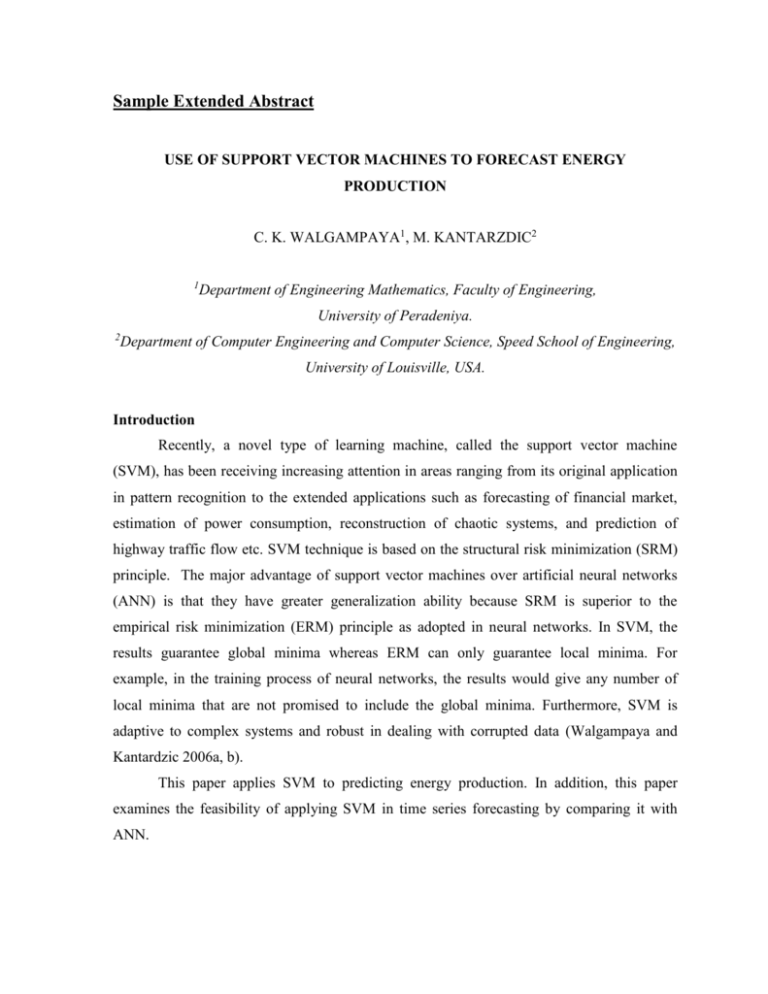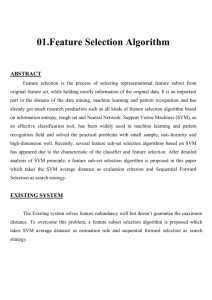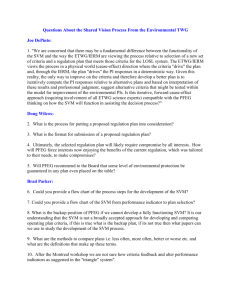SVM for Energy Production Forecasting: A Comparative Study
advertisement

Sample Extended Abstract USE OF SUPPORT VECTOR MACHINES TO FORECAST ENERGY PRODUCTION C. K. WALGAMPAYA1, M. KANTARZDIC2 1 Department of Engineering Mathematics, Faculty of Engineering, University of Peradeniya. 2 Department of Computer Engineering and Computer Science, Speed School of Engineering, University of Louisville, USA. Introduction Recently, a novel type of learning machine, called the support vector machine (SVM), has been receiving increasing attention in areas ranging from its original application in pattern recognition to the extended applications such as forecasting of financial market, estimation of power consumption, reconstruction of chaotic systems, and prediction of highway traffic flow etc. SVM technique is based on the structural risk minimization (SRM) principle. The major advantage of support vector machines over artificial neural networks (ANN) is that they have greater generalization ability because SRM is superior to the empirical risk minimization (ERM) principle as adopted in neural networks. In SVM, the results guarantee global minima whereas ERM can only guarantee local minima. For example, in the training process of neural networks, the results would give any number of local minima that are not promised to include the global minima. Furthermore, SVM is adaptive to complex systems and robust in dealing with corrupted data (Walgampaya and Kantardzic 2006a, b). This paper applies SVM to predicting energy production. In addition, this paper examines the feasibility of applying SVM in time series forecasting by comparing it with ANN. Methodology We are analyzing distributed energy production of a network of 200 energy plants in the USA and trying to build a prediction system based on the data from these sensors. The energy plants considered in this research operate through out the year continuously. Each plant keeps record of vital information including the real time power production. These data are taken at specific time intervals that can vary from a fraction of a second to a day. Data collection and pre-processing We use a repository of three years of data from year 2002 to 2004 that are collected daily. The data are normalized between [-1, 1] as most of the machine learning techniques including ANN and SVM require that all data sets to be normalized. Our main goal is to test the feasibility of using SVM as a prediction technique and to compare the performances with ANN. The data set consist of 201 time series. The first 200 correspond to the data from sensors at each energy plant whilst the additional time series is the total energy production for the region. We have built separate training and testing data sets by varying the number of sensor inputs. For example, we considered data from 10, 20, 30, 40, 70, 100, 130, 170 and 190 inputs. We have used year 2002 and 2003 data as training data sets and year 2004 data as testing data set. Experimental results ANN We used a feed forward neural network with back-propagation learning with one hidden layer. The algorithm was implemented in MATLAB ver 6.5. Inputs to the network are the data columns corresponding to sensors’ recordings and the output represents the predicted value of the energy production in the region. We have experimented with the ANN model using different combinations of the parameters and found out that values 0.001 for accuracy and 0.04 for learning rate with Tangent-Sigmoid activation function give the best prediction results. Fig. 1(a) shows the scatter plot of actual and predicted value for 70 input sensors. Table 1 shows the prediction results expressed through correlation coefficient. SVM The LIBSVM toolbox was used for SVM methodology. SVM parameters including the Kernel function, Kernel parameter C which is the upper bound between the error and margin, and the bandwidth 2 play an important role in the performance of the SVM. In this study we have utilized a non linear SVM because many studies show that use of polynomial d kernel, K x, y x * y 1 and the Gaussian radial basis function, K x, y exp 1/ 2 x y 2 perform well in prediction problems. We experimentally determined that C 100 , and 2 10 give the best prediction performances. Fig. 1(b) shows the scatter plot of actual and predicted value for 70 input sensors. Table 1 shows the prediction results expressed through correlation coefficient. Table 1: Comparison of prediction results (a) ANN with 7 0 sensors (b) SVM with 7 0 input sensors No. of inputs 10 20 30 40 70 100 130 170 190 ANN SVM 0.640 0.682 0.737 0.804 0.922 0.950 0.972 0.977 0.985 0.654 0.761 0.790 0.842 0.929 0.951 0.981 0.989 0.990 Fig. 1. Scatter plots for ANN and SVM 70 sensors Discussion As shown in Table 1 prediction accuracy increases with the increase of number of sensors that was used. Until 70 sensor inputs SVM performs much better than ANN in terms of required number of sensors for a given prediction accuracy. Both SVM and ANN results saturate around 130 input sensors, which means beyond this point improvement in the accuracy by adding new sensors is comparatively low. When the cost for sensors is an important factor these saturation points can be considered as the optimal balance between prediction accuracy and system costs. The results may be attributable to the fact that SVM implements the SRM principle and this leads to better generalization than conventional techniques. References Walgampaya, C. and Kantardzic, M., 2006a. Cost-Sensitive Analysis in Multiple Time Series Prediction. Proceedings of The 2006 International Conference on Data Mining, Las Vegas, USA. Walgampaya, C. and Kantardzic, M., 2006b. Selection of Distributed Sensors in Multiple Time Series Prediction. Proceedings of the IEEE World Congress on Computational Intelligence, Vancouver, CA.






